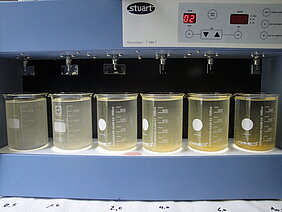As part of the literature study funded by the DVGW, information on alternatives to flocculation and flocculants was collected and a survey was carried out among the affected water suppliers about their experiences in testing the alternatives.
Flocculation is the most frequently used process in the treatment of surface water to achieve a sufficient removal of particles and colloids. Flocculants are also used for color removal and in groundwater treatment to remove iron. In microfiltration or ultrafiltration processes (MF/UF) flocculants are often used to improve the operation behavior and the efficiency of backwashing as well as to reduce its frequency.
Due to supply bottlenecks and the resulting enormous price increases for chloride-based flocculants, water supply companies were forced to think about alternative processes. This was the reason for the DVGW to support the small LitFAlter research project with the aim of collecting literature references and reports, reviewing them and putting them together in a clear form so that water suppliers can use this overview to derive suggestions for reducing or minimizing their need for flocculants and develop their own solutions. The alternatives proposed in this study go beyond those currently approved for drinking water treatment (§ 20 TrinkwV – drinking water standard).
The situation regarding the delivery conditions for flocculants has currently eased again. However, it can be assumed that such critical situations can occur unexpectedly again in the future.
In this respect, the overview also serves as a basis for being able to use treatment processes in the longer term that are operated with smaller amounts of flocculants or can even work without flocculants entirely.
Aluminum-containing FM can be used as a replacement for flocculants containing iron chloride, although appropriate process adjustments are then required. In principle, organic flocculants are also effective and suitable for the flocculation process itself. However, they have the disadvantage that they are biodegradable and can lead to a contamination of the produced drinking water.
Through the literature search, a number of processes and in particular combinations of processes were identified that work entirely without flocculants or with smaller amounts of flocculants. For the separation of particles and colloids as well as the decolorization or DOC removal, electrocoagulation, microflocculation with ozone, flotation, nanofiltration via hollow fiber membranes and ultrafiltration in combination with the addition of flocculants or powdered carbon or other additives should be mentioned. Adsorption on activated carbon and other adsorbents, ion exchange (SIX® or MIEX®) and nanofiltration via flat membranes are also suitable for removal of color or DOC.
However, the methods mentioned cannot be used in the short term, but require more complex planning measures and plant engineering construction measures for large-scale implementation.
The use of membrane filtration instead of flocculation filtration, ion exchange or activated carbon filtration, for example, still means a complete reorganization of the treatment concept, although these processes can only be used in combination. Ion exchange processes or activated carbon adsorption always require an upstream particle removal stage. In combination with ion exchange or adsorption, some patented processes are available, the possible uses and limitations of which must be examined in each individual case.

![[Translate to English:] Prüfstelle-Produktprüfung_Teststand Test centre and product testing](/fileadmin/_processed_/0/9/csm_TZW-Karlsruhe_Pruefung_Geraete-Teststand_377188946c.jpg)
























